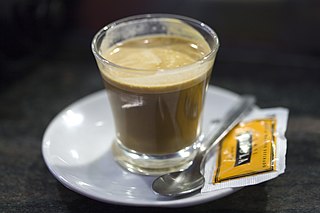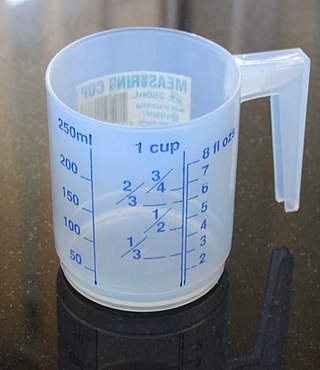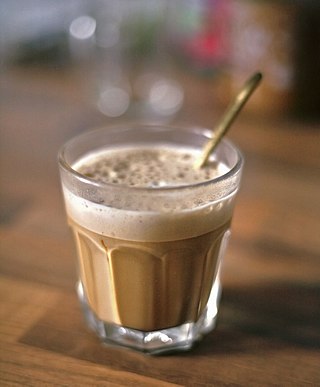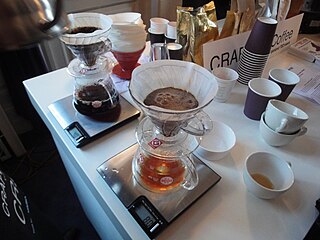
A cappuccino is an espresso-based coffee drink that originated in Italy and is traditionally prepared with steamed milk foam (microfoam).

Espresso is a coffee-brewing method of Italian origin, in which a small amount of nearly boiling water is forced under 9–10 bars of pressure through finely-ground coffee beans. Espresso can be made with a wide variety of coffee beans and roast degrees. Espresso is the most common way of making coffee in southern Europe, especially in Italy, France, Spain, and Portugal. It is also popular in Switzerland, Croatia, Bosnia and Herzegovina, Bulgaria, Greece, South Africa, the United Kingdom, the United States, Canada, Chile, Brazil, Australia and New Zealand.

A teapot is a vessel used for steeping tea leaves or a herbal mix in boiling or near-boiling water, and for serving the resulting infusion which is called tea. It is one of the core components of teaware. Dry tea is available either in tea bags or as loose tea, in which case a tea infuser or tea strainer may be of some assistance, either to hold the leaves as they steep or to catch the leaves inside the teapot when the tea is poured. Teapots usually have an opening with a lid at their top, where the dry tea and hot water are added, a handle for holding by hand and a spout through which the tea is served. Some teapots have a strainer built-in on the inner edge of the spout. A small air hole in the lid is often created to stop the spout from dripping and splashing when tea is poured. In modern times, a thermally insulating cover called a tea cosy may be used to enhance the steeping process or to prevent the contents of the teapot from cooling too rapidly.

Caffè latte, often shortened to just latte in English, is a coffee beverage of Italian origin made with espresso and steamed milk. Variants include the chocolate-flavored mocha or replacing the coffee with another beverage base such as masala chai, mate, matcha, turmeric or rooibos; alternatives to milk, such as soy milk or almond milk, are also used.

A mug is a type of cup typically used for drinking hot drinks, such as coffee, hot chocolate, or tea. Mugs usually have handles and hold a larger amount of fluid than other types of cups. Typically, a mug holds approximately 240–350 ml of liquid. A mug is a less formal style of drink container and is not usually used in formal place settings, where a teacup or coffee cup is preferred. Shaving mugs are used to assist in wet shaving.

A demitasse, demi-tasse, or espresso cup is a small cup used to serve espresso. It may also refer to the coffee served in such a cup, though that usage had disappeared in France by the early 20th century.

A cortado is a beverage consisting of espresso mixed with a roughly equal amount of warm milk to reduce the acidity. The milk in a cortado is steamed, but not frothy and "texturized" as in many Italian coffee drinks. The cortado comes from Spain, most likely Madrid, where it is commonly served.

Latte macchiato is a coffee beverage. The name means stained or marked milk, which refers to the espresso stain on the milk used. It is a play on "Espresso macchiato". an espresso with a dollop or two of milk or cream.

A flat white is a coffee drink consisting of espresso with microfoam. It is comparable to a latte, but smaller in volume and with less microfoam, therefore having a higher proportion of coffee to milk, and milk that is more velvety in consistency – allowing the espresso to dominate the flavour, while being supported by the milk.

The cup is a cooking measure of volume, commonly associated with cooking and serving sizes. In the US, it is traditionally equal to one-half US pint (236.6 ml). Because actual drinking cups may differ greatly from the size of this unit, standard measuring cups may be used, with a metric cup being 250 millilitres.

Lungo is a coffee beverage made by using an espresso machine to make an Italian-style coffee – short black with more water, resulting in a larger coffee, a lungo.

Beer glassware comprise vessels made of glass, designed or commonly used for serving and drinking beer. Styles of glassware vary in accord with national or regional traditions; legal or customary requirements regarding serving measures and fill lines; such practicalities as breakage avoidance in washing, stacking or storage; commercial promotion by breweries; artistic or cultural expression in folk art or as novelty items or usage in drinking games; or to complement, to enhance, or to otherwise affect a particular type of beer's temperature, appearance and aroma, as in the case of its head. Drinking vessels intended for beer are made from a variety of materials other than glass, including pottery, pewter, and wood.

Coffee preparation is the process of turning coffee beans into a beverage. While the particular steps vary with the type of coffee and with the raw materials, the process includes four basic steps: raw coffee beans must be roasted, the roasted coffee beans must then be ground, and the ground coffee must then be mixed with hot or cold water for a specific time (brewed), the liquid coffee extraction must be separated from the used grounds, and finally, if desired, the extracted coffee is combined with other elements of the desired beverage, such as sweeteners, dairy products, dairy alternatives, or toppings.

Milk coffee is a category of coffee-based drinks made with milk. Johan Nieuhof, the Dutch ambassador to China, is credited as the first person to drink coffee with milk when he experimented with it around 1660.

Caffè Americano is a type of coffee drink prepared by diluting an espresso with hot water, giving it a similar strength to, but different flavor from, traditionally brewed coffee. Its strength varies with the number of shots of espresso and amount of water added. The name is also spelled with varying capitalization and use of diacritics: e.g., café americano.

The AeroPress is a manual coffeemaker invented by Alan Adler, founder of AeroPress, Inc. It consists of a cylindrical chamber, and a plunger with an airtight silicone seal, similar to a syringe. Ground coffee beans and water are steeped inside, then forced through a filter by pressing the plunger through the chamber. It is capable of brewing highly concentrated coffee, which the manufacturer describes as "espresso style", but can also be used to brew filter strength coffee, or cold brew coffee.
A carajillo is a hot coffee drink to which a hard liquor is added. It is typical of Spain and several Latin American countries, such as Colombia, where it is usually made with brandy, Cuba, where it is usually made with rum, and some areas of Mexico, mezcal or a coffee liqueur such as Kahlúa or Tía María. Carajillo is usually served in a small glass.
Caffè crema refers to two different coffee drinks:

A coffeemaker, coffee maker or coffee machine is a cooking appliance used to brew coffee. While there are many different types of coffeemakers, the two most common brewing principles use gravity or pressure to move hot water through coffee grounds. In the most common devices, coffee grounds are placed into a paper or metal filter inside a funnel, which is set over a glass or ceramic coffee pot, a cooking pot in the kettle family. Cold water is poured into a separate chamber, which is then boiled and directed into the funnel and allowed to drip through the grounds under gravity. This is also called automatic drip-brew. Coffee makers that use pressure to force water through the coffee grounds are called espresso makers, and they produce espresso coffee.




















